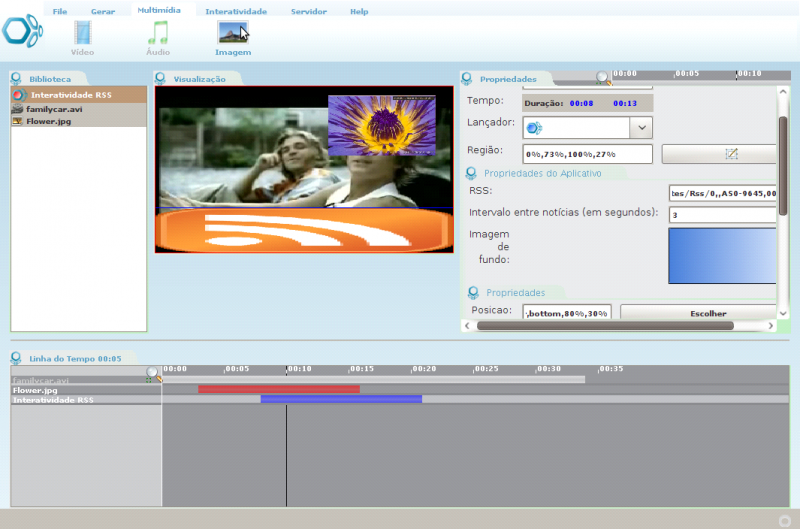Project Célula – Authoring Tool for Interactive Digital Television on the SBTVD-T (Ginga-NCL) standard
Célula consist of an environment based on a timeline created from a main media (main program). From this timeline the journalist, responsible for editing the program, can include media elements and interactive applications. The interactive applications can be sorted, edited and complemented from a model contained in the model repository. The journalist’s interaction is in the parameterization of the models, such as, background images, text, questions, rules of presentation or an alternative video. For this parameterization are available panels capable of modifying images, texts, files and groups of parameters. A library of models is available with three components considered essentials for multimedia with interactivity:
- Video – allows alternative small videos to be watched;
- Images – presents images to the viewer at the touch of the remote controle;
- Text – presents texts in scroll boxes; and
- Applications – with pre-developed models.
Aiming for the definition and future implementation of the standard Ginga-J and the use of this tool, with it’s models, on other DTV standards, we choose to develop a module capable of generating interactive applications based on the precepts of plugin. To create interactivity in an easy and efficient way it is presented a proposal of a tool (Melhor?: This tool try to achieve an easy and efficient way of creating interativity. = A ferramenta busca criar interatividade de forma fácil e eficiente) . According to queries with professors and students of journalism at UFSC, the models of interactivity, images, text, video and quizzes available in the prototype achieve the major initial requirements of interactivity. In the next section are exposed some details of the authoring tool available in the proposed method. The interface has, besides a top menu, four main panels: a media library; a panel for editing the selected media properties; a preview panel; and the timeline. In the current version, the software works as follows:
- The media are added to the library from the top menu;
- The media availble in the library can be inserted into the timeline, through a drag and drop action;
- The video inserted into the first position of the timeline is defined as the main program;
- The same media can be inserted into the timeline as many times as needed;
- The media inserted into the timeline will be available in the main flow of the program generated;
- When clicking a media in the time line, it’s properties will be made available on the properties panel;
- In the properties panel you can change the basic attributes of a media, such as name, start time, duration, position, size and the color of the button used to open the media during playing time;
- The same button color selected to open the media is used in the timeline, showing the interval that the media will be available to the viewer;
- In the case of the media selected is an interactive applica tion, the properties panel also shows the parameters available to customize the interaction, such as, a text or the color of the text;
- The time line also allows editing of the instant and interval which the selected media will be available.
The Célula also has internationalization support, where the users selects the tool’s languague (currently english and brazilian portuguese). The figure below shows the Célula in the current version. In the following subsections some features are explained in more details.
